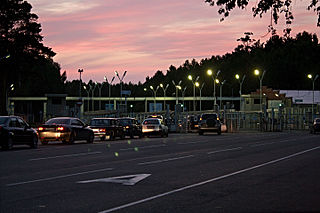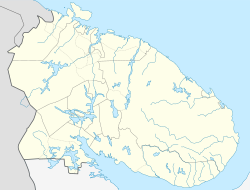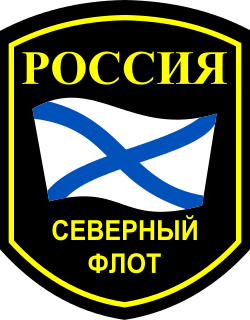
Polyarny is a town and the administrative center of the closed administrative-territorial formation of Alexandrovsk in Murmansk Oblast, Russia, situated on the outermost western side of the Kola Bay. Population: 17,293 (2010 Census); 18,552 (2002 Census); 27,635 (1989 Census).

Vidyayevo is a closed rural inhabited locality in Murmansk Oblast, Russia. Despite having a rural status, it is municipally incorporated as Vidyayevo Urban Okrug, as such status is the only one allowed by the federal law for closed inhabited localities. Population: 5,771 (2010 Census); 6,307.

Apatity is a town in Murmansk Oblast, Russia, located along the Murman Railway between Lake Imandra and the Khibiny Mountains, 23 km (14 mi) west of Kirovsk and 185 km (115 mi) south of Murmansk, the administrative center of the oblast. The town is named after one of its most abundant natural resources in the area, apatite, the raw mineral used in the production of phosphorus mineral fertilizers. Population: 59,672 (2010 Census).

Monchegorsk is a town in Murmansk Oblast, Russia, located on the Kola Peninsula, 145 kilometers (90 mi) south of Murmansk, the administrative center of the oblast. Population: 45,361 (2010 Census); 52,242 ; 68,652.

Zaozyorsk, formerly known as Zaozyorny (Заозёрный), Severomorsk-7 (Североморск-7), and Murmansk-150 (Му́рманск-150), is a closed town in Murmansk Oblast, Russia. As of the 2010 Census, its population was 11,199; down from 12,687 recorded in the 2002 Census.

Gadzhiyevo is a town under the administrative jurisdiction of the closed administrative-territorial formation of Alexandrovsk in Murmansk Oblast, Russia. Population: 11,068 (2010 Census); 12,180 (2002 Census).

Olenegorsk is a town in Murmansk Oblast, Russia, located north of the Arctic Circle, 112 kilometers (70 mi) south of Murmansk. Population: 23,072 (2010 Census); 25,166 ; 35,584 (1989 Census).
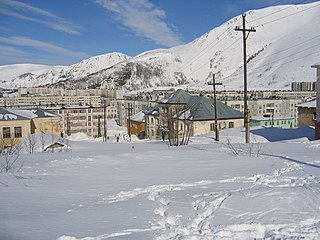
Kirovsk, known as Khibinogorsk (Хибиного́рск) until 1934, is a town in Murmansk Oblast, Russia, located at the spurs of the Khibiny Mountains on the shores of the Lake Bolshoy Vudyavr, 175 kilometers (109 mi) south of Murmansk. Population: 28,625 (2010 Census).

Ostrovnoy, previously known as Murmansk-140 (Му́рманск-140), is a closed town in Murmansk Oblast, Russia. As of the 2010 Census, its population was 2,171; down from 5,032 recorded in the 2002 Census.
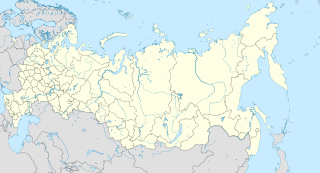
Polyarnye Zori is a town in Murmansk Oblast, Russia, located on the Niva River, Lake Imandra, and Lake Pinozero, 224 kilometers (139 mi) south of Murmansk. Population: 15,096 (2010 Census); 15,910 (2002 Census); 19,428 (1989 Census).

Lovozersky District is an administrative district (raion), one of the six in Murmansk Oblast, Russia. Municipally, it is incorporated as Lovozersky Municipal District. It occupies most of the central and northeastern parts of the Kola Peninsula. The area of the district is 53,800 square kilometers (20,800 sq mi). Its administrative center is the rural locality of Lovozero. District's population: 11,820 (2010 Census); 14,311 (2002 Census); 18,263 (1989 Census). The population of Lovozero accounts for 24.3% of the district's total population.
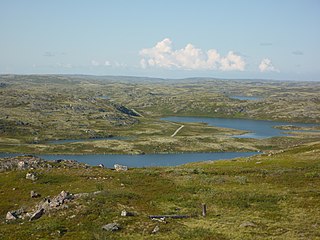
Pechengsky District is an administrative district (raion), one of the six in Murmansk Oblast, Russia. As a municipal division, it is incorporated as Pechengsky Municipal District. It is located in the northwest of the oblast, on the coast of the Barents Sea and borders Finland in the south and southwest and Norway in the west, northwest, and north. The area of the district is 8,662.22 square kilometers (3,344.50 sq mi). Its administrative center is the urban locality of Nikel. Population: 38,920 (2010 Census); 46,404 (2002 Census); 59,495 (1989 Census). The population of Nikel accounts for 32.8% of the district's total population.

Roslyakovo' was an urban locality under the administrative jurisdiction of the closed-administrative territorial formation of Severomorsk in Murmansk Oblast, Russia, located on the Kola Peninsula on the Kola Bay, 6 kilometers (3.7 mi) west of Severomorsk proper. It was abolished, with its territory merged into the city of Murmansk, on January 1, 2015. Population: 8,696 (2010 Census); 9,458 (2002 Census); 11,981 (1989 Census).

Safonovo is an urban locality under the administrative jurisdiction of the closed-administrative territorial formation of Severomorsk in Murmansk Oblast, Russia, located on the Kola Peninsula on the Kola Bay, 3 kilometers (1.9 mi) west of Severomorsk proper. Population: 5,255 (2010 Census); 4,853 (2002 Census); 7,661 (1989 Census).

Belokamenka is a rural locality in administrative jurisdiction of the closed administrative-territorial formation of Alexandrovsk in Murmansk Oblast, Russia, located beyond the Arctic Circle at a height of 1 meter above sea level. As of the 2010 Census, it had a population of 84.

Retinskoye is a rural locality in administrative jurisdiction of the closed administrative-territorial formation of Alexandrovsk in Murmansk Oblast, Russia, located beyond the Arctic Circle at a height of 1 meter above sea level. As of the 2010 Census, it had no recorded population.

Kuvshinskaya Salma is a rural locality in administrative jurisdiction of the closed administrative-territorial formation of Alexandrovsk in Murmansk Oblast, Russia, located beyond the Arctic Circle at the height of 1 meter above sea level. As of the 2010 Census, it had no recorded population.

Kandalakshsky District is an administrative district, one of the six in Murmansk Oblast, Russia. As a municipal division, it is incorporated as Kandalakshsky Municipal District. It is located in the southwest of the oblast, and borders with Kovdorsky District to the north, Loukhsky District of the Republic of Karelia, and with Finland to the west. The area of the district is 14,400 square kilometers (5,600 sq mi). Its administrative center is the town of Kandalaksha. Population: 49,544 (2010 Census); 60,140 (2002 Census); 78,239 (1989 Census). The population of Kandalaksha accounts for 72.0% of the district's total population.

Olenya Guba is a rural locality in administrative jurisdiction of the closed administrative-territorial formation of Alexandrovsk in Murmansk Oblast, Russia. As of the 2010 Census, its population was 1,661.





